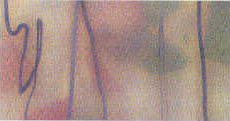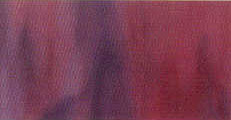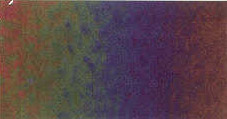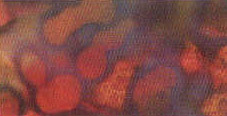|
Bullseye |
|
Stained Glass - With equipment, techniques and glass formulae similar to those used at the turn of the century, Bullseye Glass Co. began in 1974 to reproduce the finest qualities of the early American opalescent and cathedral glasses. The single-roller method of manufacturing was key in replicating the authentic look of the best Tiffany style glasses. Only with this method could the famous Catspaw and Fracture-Streamer effects be achieved. Drawing from experiments in its highly successful series of "Saturday Glasses", Bullseye has introduced numerous new styles designed especially for traditional or representational leaded and foiled glasswork. Most of the new glasses are multi-coloured mixes, many are streaked with vibrant pinks, and some of the boldest are rippled. Glass for Kilnwork - Bullseye glasses for kilnwork are formulated and manufactured specifically for a wide variety of kilnforming usage: fusing, slumping, kilncasting, pâté de verre, and flash fusing. Compatibility, colour, stability and resistance to devitrification are the primary criteria used to select a glass for kilnwork. Since 1980 Bullseye Glass Co. has worked with many of the world's foremost artists of these techniques to understand their needs and to provide glasses which can withstand the high temperatures and other demands characteristic of these processes.
|
|
Solid Colour Opalescents: Catspaw The gently undulating surface and softly mottled transmission of the original
single-rolled "Catspaw" make Bullseye's standard single-rolled glass
("-00") ideal for reproducing the traditional look of old lamps and windows.
The "-00" suffix indicates the single-rolled sheet. Order
"-30" for the flatter, double-rolled counterpart. The single-rolled and
double-rolled products are the same price. Most solid colour opalescents are available in non-Tested Compatible, though most products listed below are indicated as being tested compatible with the applicable "Y" surcharge.
|
|
Solid Colour Transparents Due to single-rolling, these "-00" transparent sheets have a very slightly
modular texture on the backside. The texture subtly obscures the transmission and
closely replicates the effects of older hand-cast cathedral glasses. All Bullseye
cathedrals are also available in thin ("-50") or in the flatter, double-rolled
("-30") variety.
|
|
Ripples Bullseye produces a number of different surface textures. Some, such as the "-21" softly rippled multi-coloured streakies, are part of the standard product line. The very gentle and slightly irregular "-21" standard ripple has an organic quality that makes it especially appropriate for naturalistic representations in glass. Distant mountain ranges, sunset skylines, wind-swept ponds and gnarled branches are all easily found within the rolling patterns and swirls of these hand-cast ripples.
|
Collage Glasses Collage glasses are made by arranging pre-formed glass elements - either frits, stringers or confetti - onto the glass rolling table. Clear glass is ladled over these elements and rolled into a flat sheet. The sheet is then reheated to fuse all components together. The thin threads of glass are called "stringers" before they are melted into the sheet. After being incorporated into the hot sheet - where they twist and curve under the force of the molten glass - they are called "streamers". The thin shards of glass are called "confetti" before they are melted into the sheet. Once in the sheet, refer to them as "fractures".
|
Mardi Gras Glass
|
Streamers on Clear Threads of glass cascade across a clear sheet. Alone or used to plate over other
sheets, streamer glasses offer coloured linear details not possible with any other glass.
|
Fractures & Streamers on Clear Paper-thin shards of coloured glass afloat in a field of streamers, Fractures &
Streamers are appropriate for both naturalistic and abstract usages. All streamers
are black unless otherwise noted.
|
Fractures & Streamers on White Opal Use these glasses to create the illusion of depth. When viewed through the hazy white opalescent base glass the fractures appear diffused and out of focus, as if seen from a distance. Turn the same glass around to position the fractures on the front within the same design. The contrast between clearly defined fractures on the front and muted, opal shrouded fractures on the back further heightens the sense of depth.
|
Streakies Although originally designed for traditional stained glass use, Bullseye streakies are frequently used in fusing and other kilnforming applications. Compatibility of Bullseye's two-colour streakies is determined by testing each component glass within the mixed sheet. Clearly, this makes the production of compatible streakies more difficult than the production of single colour glasses. This fact occasionally affects availability. Bullseye's streakies are a combination of opalescent and opalescent or transparent and opalescent glasses. Glass colours are listed in order of proportion within the sheet, the first colour being predominant. All colours not indicated as opals are transparent.
|
Iridescents The iridescent coating on Bullseye glasses is created by applying a fine metal chloride
mist to the glass sheet while it is semi-molten. While still pliable the sheet is
stretched to break the thin surface coating and impart the characteristically matte finish
that distinguishes Bullseye irids. Irid coatings are available on both single (-10)
and double-rolled (-31) Bullseye.
|
Ring Mottles The characteristic ring of opalescence in this unique glass results from a combination of glass formulation and forming method. The molten glass must chill momentarily before reheating to cause the rings to form. Time and temperature are critical and minute adjustments on the casting table and in the reheating chamber require extreme skill and concentration by the glassmakers. "Chiaroscuro" ("light-dark") refers to a method of shading which gives the illusion of depth or dimension to the object represented. Ring mottle glasses are especially useful in achieving this effect. The variation in opalescence due to the mottle formation allows for very subtle shading in the composition. The smaller mottles work well in simulating grapes, cherries, or wisteria blossoms. The larger, more irregular mottle patterns can be used to replicate dappled sunlight within a cluster of leaves or flower blossoms.
|










